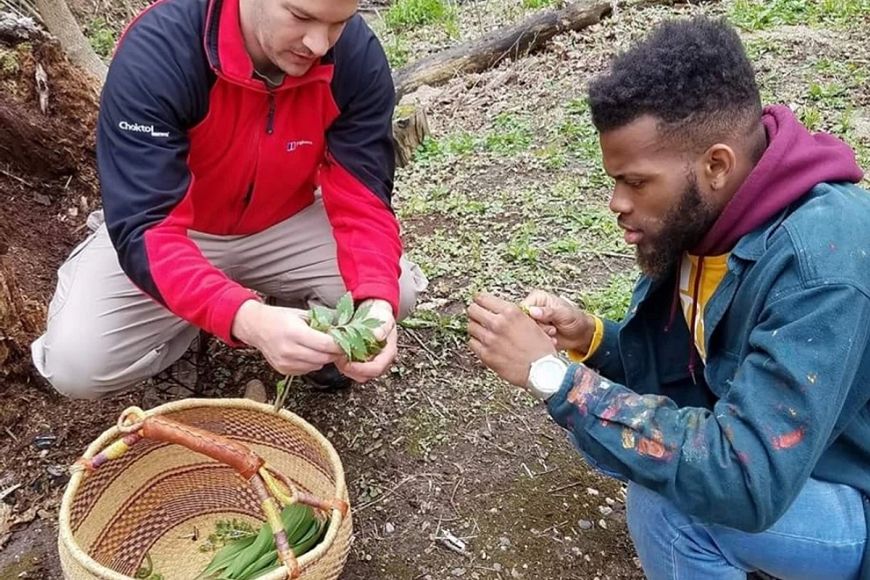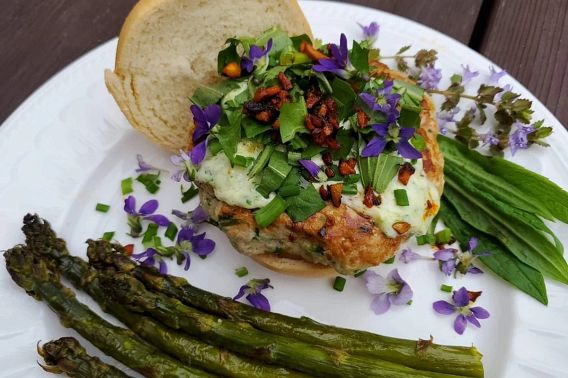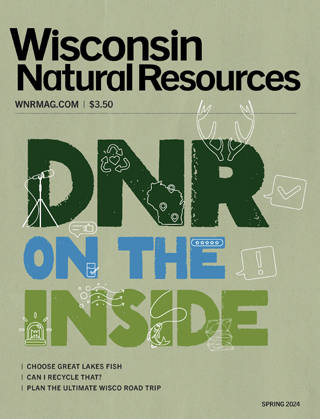FIND YOUR FOOD
Foraging can be a fun way to get outdoors and put good eats on the table
Megan Sheridan
 PHOTO COURTESY OF MATT NORMANSELLFor foraging educator Matt Normansell of Eden Wild Food, in-person classes as seen in May 2019 have largely been replaced by online groups during the coronavirus pandemic, with more people seeking out digital content to learn how to forage for food.
PHOTO COURTESY OF MATT NORMANSELLFor foraging educator Matt Normansell of Eden Wild Food, in-person classes as seen in May 2019 have largely been replaced by online groups during the coronavirus pandemic, with more people seeking out digital content to learn how to forage for food.As winter’s chill works itself into a thaw and green begins to color the landscape, it is prime time to sleuth out some of Wisconsin’s most delicious hidden gems.
Foraging is an endless, wide-ranging skill that is also a frugal way to fill your pantry and fridge. It’s especially useful when people seek out activities that encourage outdoor, solo fun.
But how do you get started?
Matt Normansell, a foraging educator and owner of Eden Wild Food, provides the simplest advice: Be curious.
“Fire up your curiosity,” he said. “Look but don’t seek. Start to look at what’s around you and build a relationship with your environment.”
Think of your favorite fruit or vegetable. There is likely a Wisconsin equivalent growing not too far from your home. Start there and learn as much as you can.
“Don’t think about ‘learning’ foraging,” said Sam Thayer of Forager’s Harvest in Bruce. “Think about learning one plant or one mushroom thoroughly and well.
“It’s not like learning a new language, where you have to know the grammar and a whole bunch of words to start using it. You just need to know one, whether that’s black raspberries or asparagus.”
Thayer considers foraging to be a cumulative skill and by learning one plant or fungi well, you can build on that knowledge to discover a greater variety of forageable things.
GROWING INTEREST
With more people seeking a wide breadth of solo activities during the COVID-19 pandemic, Normansell has seen increasing numbers join online groups and search digital content, although in-person classes are currently on hold.
“I have noticed an increase in traffic on the online groups, and demand for digital content in the foraging world seems to be on the increase,” he said. “In times where being close to people has become problematic, foraging is a pastime that’s very COVID-friendly.”
Eden Wild Food and Foragers Harvest each have websites featuring extensive foraging information, including learning opportunities and details on where to purchase foraged goods. Visit Eden Wild Food and Forager's Harvest.
Both Normansell and Thayer began foraging in earnest as children and learning from family, which means that, yes, foraging is a family-friendly activity.
Being curious, inquisitive and lower to the ground, kids can get in on the hunt and have success, too, as long as they’re not putting any unknown harvests in their mouths as snacks along the way.
WHERE CAN I FORAGE?
The rules of where you can forage in Wisconsin are slightly different, depending on the ownership of the property.
- Private lands: If you’d like to forage on private land you do not own, ask permission.
- Federal lands: Foraging is allowed; however, the rules can differ from place to place. For instance, the St. Croix Wetland Management District allows foraging of berries and mushrooms for personal use. On the Apostle Islands, fruits, berries and nuts can be foraged for personal use, but collecting other natural objects such as rocks, wildflowers and driftwood is not allowed. There are foraging limits in the Apostle Islands of one gallon per person, per week of fruits, berries and mushrooms and five gallons per person, per week for apples. Check with the property manager of federal lands before you start.
- State lands: Foraging is allowed on state properties. Take a look at the sidebar below for specifics on what kinds of foraging are permitted.
- County lands: Counties can set their own rules for foraging. Foraging is not allowed in Milwaukee County Parks, for instance, but is allowed in Dane County Parks, which goes so far as to recommend park locations to find in-demand foods — Dane County Parks - Foraging.
- Municipal properties: These also can set their own foraging rules. Call your local parks department or municipal clerk to find out what restrictions may apply in your area.
It’s important to note that you do not need to live in a rural community to forage. You can forage in your back yard, so to speak, even if you don’t have one.
FORAGING ETHICS
Outside of the rules placed on properties by governing bodies, there also are some ethical standards for foraging.
“Never take more than you need and try and understand the life cycles of what you harvest to ensure what you are doing is always sustainable,” Normansell said. “This especially can include eating invasive species, which have the added benefit that you can take as much as you like, e.g., autumn olive, garlic mustard, etc.”
Also, if you have to damage a plant or tree in order to harvest, like cutting or breaking a branch to get at good fruit, don’t do it. It could cause further harm and reduce the next season’s harvest.
FORAGING SEASONS
Like many Wisconsinites, Thayer has deer season and the fish opener on his mental calendar every year. Outside of hunting and fishing, he also makes note of about 100 other seasons for things like blueberries and spring greens.
“For me, my entire emotional experience of a year is like a constant cycle of things I’m excited about one and then the next and then the next,” Thayer said.
Foraging can happen nearly year-round, but most opportunities start in March and run through November.
“The climax of the summer brings forth a bounty of wild fruits,” Normansell said. “The late summer fungi are still around, but the real stars of the fall fungi are starting to pop.
“This is the time when you never quite know what you will come home with, but you’re usually guaranteed to find something.”
Thayer’s best advice is the simplest: “When you’re looking for food, look for disturbance.”
Areas that have seen disturbance — whether it’s flooding, fire or deposits of material like dead leaves or compost — are likely to have a bounty of vegetables.
Here are the seasons for some of the state’s most popular “found foods.”
- Morel mushrooms: It can start as early as March and run as late as May, depending on where you live in Wisconsin. Prime time for morel mushrooms occurs with daytime temperatures in the 60s and overnight temperatures in the 40s. A little bit of rain and a little bit of sun help these mushrooms spring up.
- Ramps: Also known as wild leeks, ramps are an onion-y favorite of many foragers. They are most easily spotted around the same time as morels, in spring.
- Asparagus: This is also a springtime harvest, and some say one of the easiest to find because it is hard to mistake it for another plant. Keep an eye out starting in mid-April, and always remember to leave some intact spears behind — asparagus that goes to seed grows more asparagus next season.
- Blueberries: Likely, you’ve picked some up before at your local farmer’s market, but finding them on your own is easy, especially if you live in the northern two-thirds of the state. They’re typically ready for harvest starting in early July and running through mid-August.
- Black raspberries/black caps: These berries tend to show up in the peak of summer, usually around mid-July. They’re milder than the conventional raspberries picked up in the grocery store but still quite sweet.
FORAGING SAFETY
A lot of foraged food, especially mushrooms and berries, have look-alikes or go from being edible to inedible, or vice versa, as they ripen/age.
“Don’t eat something unless you’re 100% certain of what it is and that it’s safe to eat,” Thayer said. “People have heard of poisonings, but when you look into specific cases, it’s generally people eating unidentified plants. It’s very rare that it’s a misidentified plant.”
Normansell said poisonings are often the result of wishful thinking, such as hoping to find chanterelle mushrooms and instead finding and eating jack-o’-lanterns, putting you in severe gastrointestinal distress.
“The biggest mistakes in foraging come from trying to seek out a certain plant or fungi, and more than its fair share of poisonings historically come from a bad case of wishful thinking,” he said.
Also, pay attention to where you harvest. If you’re near a roadway or farmland, what you’re foraging may have come in contact with fertilizer, herbicides or pesticides as well as dirt and exhaust. As always, anything foraged needs a good wash before eating.
 PHOTO COURTESY OF MATT NORMANSELLWild greens and foraged asparagus perfectly complement a wild turkey burger.
PHOTO COURTESY OF MATT NORMANSELLWild greens and foraged asparagus perfectly complement a wild turkey burger.FORAGING TOOLS
What you bring may depend on what you’re looking for, but generally, the most useful tools are simple.
♦ Cutting: Sometimes, what you’re foraging will take pruning shears, kitchen scissors or a garden knife to harvest.
♦ Carrying: Carry your harvest in buckets, bags or baskets. If you’re foraging for fungi, use a porous, natural weave bag or wicker basket to collect. That allows mushrooms to drop spores as you move, helping them propagate and grow more for the next season.
♦ Hiking gear: Much like if you were going for a hike, make sure you have the essentials including good footwear, water, sun protection, bug/tick repellent and navigation tools.
If you’re already an outdoors person, you’re halfway there when it comes to foraging. It’s a great complementary skill, especially for Wisconsin hunters, Normansell said.
“Many times (when hunting), you can come home without your desired quarry,” he said. “Foraging allows you to be able to add to the wild food you consume and often come home with something to eat when the hunting gods have not favored you that day.”
Thayer also is an avid hunter and angler and likes to think of foraging as the other side of the coin. He said most people probably have “foraged” already but don’t consider picking a wild berry or nut just that.
“We all spend time outdoors foraging, but we just don’t call it that,” he said. “Almost everybody has collected or eaten something in the wild, and they don’t think of it as foraging. Everybody is interested in this — it’s instinctively human.”
Megan Sheridan, formerly in the DNR’s Office of Communications, enjoys foraging for food whenever the opportunity allows.
MORE ON FORAGING
For more on foraging, including tips on how to prepare your found food, see culinary writer Kyle Cherek’s Taste of Wisconsin column.
FORAGING ON STATE LANDS
You can find wild edibles just about anywhere, even as close as your back yard. But did you know you can forage on state-owned properties in Wisconsin? Please be aware of the rules that apply.
As granted by state law, foraging at state parks, forests, natural areas, recreation and wildlife areas does not require a permit for the following:
- Edible fruits such as apples, plums, pears, blueberries, raspberries, blackberries, juneberries and strawberries;
- Edible nuts like walnuts, hickory nuts, acorns and other similar nuts from trees and shrubs;
- Wild mushrooms including morel, oyster, lobster, chanterelle, giant puffball and hen of the woods varieties;
- Wild asparagus and watercress;
- Garlic mustard and other invasive species listed in Ch. NR 40, Wis. Adm. Code (for full text, go to Invasive Species Rule - NR 40).
Foraging is allowed only for personal consumption by the collector. Gathering seeds, leaves, stems, roots or other plant parts is not allowed — including medicinal herbs and wild leeks or ramps.
Some properties may be deemed a “non-collection site.” When in doubt, contact the property manager or call the DNR to see if a property has any restrictions.
No foraging is allowed for species listed as endangered or threatened. In addition, specific rules apply to harvesting wild rice, so know before you go — Wild Rice Harvesting. Wisconsin law also regulates the harvesting of wild ginseng; for details, check Wisconsin Wild Ginseng Program.
Are you looking to gather pine boughs for the holidays or another non-edible forest product? That requires a permit. Check Timber Sales for information.
— MEGAN SHERIDAN

